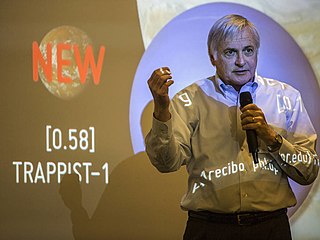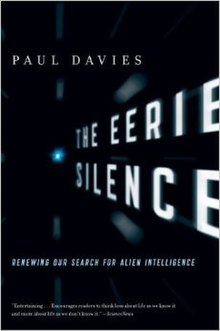
The Drake equation is a probabilistic argument used to estimate the number of active, communicative extraterrestrial civilizations in the Milky Way Galaxy.

The Fermi paradox is the discrepancy between the lack of conclusive evidence of advanced extraterrestrial life and the apparently high likelihood of its existence. Those affirming the paradox generally conclude that if the conditions required for life to arise from non-living matter are as permissive as the available evidence on Earth indicates, then extraterrestrial life would be sufficiently common such that it would be implausible for it not to have been detected yet.
Lincos is a constructed language first described in 1960 by Dr. Hans Freudenthal in his book Lincos: Design of a Language for Cosmic Intercourse, Part 1. It is a language designed to be understandable by any possible intelligent extraterrestrial life form, for use in interstellar radio transmissions. Freudenthal considered that such a language should be easily understood by beings not acquainted with any Earthling syntax or language. Lincos was designed to be capable of encapsulating "the whole bulk of our knowledge".
The search for extraterrestrial intelligence (SETI) is a collective term for scientific searches for intelligent extraterrestrial life, for example, monitoring electromagnetic radiation for signs of transmissions from civilizations on other planets.

Frank Donald Drake was an American astrophysicist and astrobiologist.

The Kardashev scale is a method of measuring a civilization's level of technological advancement based on the amount of energy it is capable of harnessing and using. The measure was proposed by Soviet astronomer Nikolai Kardashev (1932–2019) in 1964 and was named after him.
Extraterrestrial intelligence (ETI) refers to hypothetical intelligent extraterrestrial life. No such life has ever been verifiably observed to exist. The question of whether other inhabited worlds might exist has been debated since ancient times. The modern form of the concept emerged when the Copernican Revolution demonstrated that the Earth was a planet revolving around the Sun, and other planets were, conversely, other worlds. The question of whether other inhabited planets or moons exist was a natural consequence of this new understanding. It has become one of the most speculative questions in science and is a central theme of science fiction and popular culture.

Jill Cornell Tarter is an American astronomer best known for her work on the search for extraterrestrial intelligence (SETI). Tarter is the former director of the Center for SETI Research, holding the Bernard M. Oliver Chair for SETI at the SETI Institute. In 2002, Discover magazine recognized her as one of the 50 most important women in science.

Seth Shostak is an American astronomer and author, and is currently the senior astronomer for the SETI Institute.
The zoo hypothesis speculates on the assumed behavior and existence of technologically advanced extraterrestrial life and the reasons they refrain from contacting Earth. It is one of many theoretical explanations for the Fermi paradox. The hypothesis states that extraterrestrial life intentionally avoids communication with Earth to allow for natural evolution and sociocultural development, and avoiding interplanetary contamination, similar to people observing animals at a zoo. The hypothesis seeks to explain the apparent absence of extraterrestrial life despite its generally accepted plausibility and hence the reasonable expectation of its existence.
The Great Filter is the idea that, in the development of life from the earliest stages of abiogenesis to reaching the highest levels of development on the Kardashev scale, there is a barrier to development that makes detectable extraterrestrial life exceedingly rare. The Great Filter is one possible resolution of the Fermi paradox.

The communication with extraterrestrial intelligence (CETI) is a branch of the search for extraterrestrial intelligence (SETI) that focuses on composing and deciphering interstellar messages that theoretically could be understood by another technological civilization. The best-known CETI experiment of its kind was the 1974 Arecibo message composed by Frank Drake.
Active SETI is the attempt to send messages to intelligent extraterrestrial life. Active SETI messages are predominantly sent in the form of radio signals. Physical messages like that of the Pioneer plaque may also be considered an active SETI message. Active SETI is also known as METI.
The cultural impact of extraterrestrial contact is the corpus of changes to terrestrial science, technology, religion, politics, and ecosystems resulting from contact with an extraterrestrial civilization. This concept is closely related to the search for extraterrestrial intelligence (SETI), which attempts to locate intelligent life as opposed to analyzing the implications of contact with that life.

Technosignature or technomarker is any measurable property or effect that provides scientific evidence of past or present technology. Technosignatures are analogous to biosignatures, which signal the presence of life, whether intelligent or not. Some authors prefer to exclude radio transmissions from the definition, but such restrictive usage is not widespread. Jill Tarter has proposed that the search for extraterrestrial intelligence (SETI) be renamed "the search for technosignatures". Various types of technosignatures, such as radiation leakage from megascale astroengineering installations such as Dyson spheres, the light from an extraterrestrial ecumenopolis, or Shkadov thrusters with the power to alter the orbits of stars around the Galactic Center, may be detectable with hypertelescopes. Some examples of technosignatures are described in Paul Davies's 2010 book The Eerie Silence, although the terms "technosignature" and "technomarker" do not appear in the book.
Information panspermia is the concept of life forms travelling across the universe by means of transmission of compressed information representing said life forms e.g. via genome coding, which can then enable the recovery of intelligent life.

Archaeology, Anthropology, and Interstellar Communication is a 2014 collection of essays edited by Douglas Vakoch and published by NASA. The book is focused on the role that the humanities and social sciences, in particular anthropology and archaeology, play in the search for extraterrestrial intelligence (SETI). The seventeen essays are gathered into four sections, which respectively explore the history of SETI as a field; archaeological comparisons for human-alien communication, such as the difficulties of translating ancient languages; the inferential gap between humans and aliens, and the consequences this would have for communication and trade; and the potential nature of alien intelligences.

The following outline is provided as an overview of and topical guide to extraterrestrial life:
The Hart–Tipler conjecture is the idea that an absence of detectable Von Neumann probes is contrapositive evidence that no intelligent life exists outside of the Solar System. This idea was first proposed in opposition to the Drake equation in a 1975 paper by Michael H. Hart titled "Explanation for the Absence of Extraterrestrials on Earth". Assuming that the probes traveled at 1/10 the speed of light and that no time was lost in building new ships upon arriving at the destination, Hart surmised that a wave of Von Neumann probes could cross the galaxy in approximately 650,000 years, a comparatively minimal span of time relative to the estimated age of the universe at 13.7 billion years. Hart’s argument was extended by cosmologist Frank Tipler in his 1981 paper entitled "Extraterrestrial intelligent beings do not exist".










